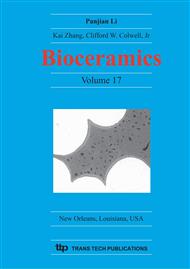p.93
p.97
p.101
p.105
p.109
p.113
p.117
p.121
p.125
Preliminary Investigation of Bone Cement Using Calcium Phosphate Glass
Abstract:
The mixed pastes of binary calcium phosphate glass with Ca/P ratio of 0.6 and distilled water were set after about 4 hr, while never set when calcium phosphate glass with Ca/P lower than 0.5. Their compressive strength was ranged from 16.0 to 23.3 MPa. When Na2HPO4 solution was used instead of distilled water as liquid phase, the setting time became drastically much shorter. As the mole concentration of Na2HPO4 solution increased from 0.25 M to 2 M, setting time was shortened to 35 min from almost 3 hr, but compressive strength decreased from 28.8 MPa to 13.2 MPa. At constant mole concentration, as the mass ratio of a powder to liquid ratio increased, setting time was shortened and maximum compressive strength was measured when a powder/liquid ratio was 2.5. However, no crystallized phases were detected either during setting or after complete setting. The XRD , FT-IR and SEM examinations indicated that calcium phosphate glass dissolved and then glass phase precipitated again. We concluded, therefore, that Na2HPO4 just affected the kinetics of dissolution and precipitation of CPG. The mechanism of hardening has yet to be studied.
Info:
Periodical:
Pages:
109-112
Citation:
Online since:
April 2005
Price:
Сopyright:
© 2005 Trans Tech Publications Ltd. All Rights Reserved
Share:
Citation:


